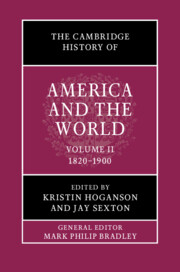Book contents
- The Cambridge History of America and the World
- The Cambridge History of America and the World
- The Cambridge History of America and the World
- Copyright page
- Contents
- Figures
- Maps
- Tables
- Contributors to Volume II
- General Introduction: What is America and the World?
- Introduction to Volume II
- Part I Building and Resisting US Empire
- Part II Imperial Structures
- 9 The US Fiscal-Military State and the Conquest of a Continent, 1783–1900
- 10 The United States and International Law: From the Transcontinental Treaty to the League of Nations Covenant, 1819–1919
- 11 The United States and Global Capitalism
- 12 Making the First International: Nineteenth-Century Regimes of Surveillance, Accumulation, Resistance, and Abolition
- 13 The Military and US Engagements with the World, 1865–1900
- 14 Technology and US Foreign Relations in the Nineteenth Century
- 15 The Environment, the United States, and the World in the Nineteenth Century
- Part III Americans and the World
- Part IV Americans in the World
- Index
14 - Technology and US Foreign Relations in the Nineteenth Century
from Part II - Imperial Structures
Published online by Cambridge University Press: 12 November 2021
- The Cambridge History of America and the World
- The Cambridge History of America and the World
- The Cambridge History of America and the World
- Copyright page
- Contents
- Figures
- Maps
- Tables
- Contributors to Volume II
- General Introduction: What is America and the World?
- Introduction to Volume II
- Part I Building and Resisting US Empire
- Part II Imperial Structures
- 9 The US Fiscal-Military State and the Conquest of a Continent, 1783–1900
- 10 The United States and International Law: From the Transcontinental Treaty to the League of Nations Covenant, 1819–1919
- 11 The United States and Global Capitalism
- 12 Making the First International: Nineteenth-Century Regimes of Surveillance, Accumulation, Resistance, and Abolition
- 13 The Military and US Engagements with the World, 1865–1900
- 14 Technology and US Foreign Relations in the Nineteenth Century
- 15 The Environment, the United States, and the World in the Nineteenth Century
- Part III Americans and the World
- Part IV Americans in the World
- Index
Summary
When William Henry Seward reflected in 1854 on the vast geographic and material growth of his country, he echoed most Americans’ views of technological innovation. “He wanted machines for working up his forests, and he invented the saw-gang, and the grooving and planning machines,” Seward declared of his fellow American. He sought machines “for cleaning his cotton, and he invented the gin; for harvesting wheat, and he invented the reaper. He needed mechanical force to navigate his long rivers and broad lakes, and he converted the steam engine into a marine power. He needed dispatch in communicating intelligence, and he placed his lightning-rod horizontally, and beating it into a wire, converted it into a writing telegraph.”1 As secretary of state, Seward would be among the Americans to push technological innovation into the service of foreign policy.
- Type
- Chapter
- Information
- The Cambridge History of America and the World , pp. 337 - 360Publisher: Cambridge University PressPrint publication year: 2022



